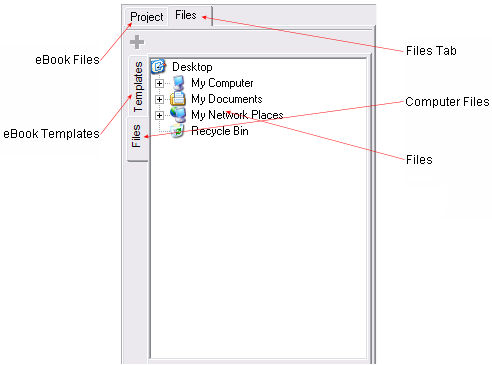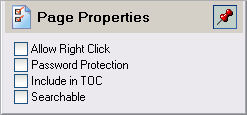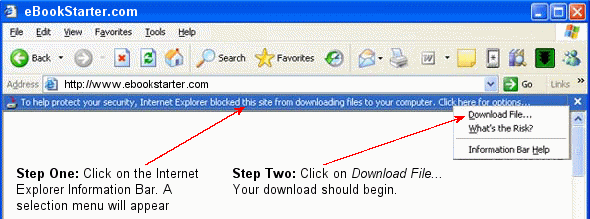Creating an eBook with Your Own Files Using the 'New Project' Button
 Creating an eBook with Your Own Files Using the 'New Project' Button
Creating an eBook with Your Own Files Using the 'New Project' Button
This method of creating an ebook will require that you create your ebook manually (without the step by step wizard) and have your own web page (HTML) files already created.
![]() Starting Your Project
Starting Your Project
Your first step in creating your new eBook will be to click on the 'New Project' icon on the eBook Starter toolbar. This will open the 'Files Window.'
Next, click on the top 'Files' tab and select the 'Files' tab on the left to view the files on your computer -- they will be displayed within the 'Files Window.'
Files Window:

![]() Adding Your File Folder to Your Project
Adding Your File Folder to Your Project
To add your '![]() Files' to your project, click on the '
Files' to your project, click on the '![]() Folder' containing your eBook files to highlight, and then on the
Folder' containing your eBook files to highlight, and then on the ![]() to add your '
to add your '![]() Files' to your eBook Project.
Files' to your eBook Project.
![]() Adding Your Individual Files to Your Project
Adding Your Individual Files to Your Project
You can add individual '![]() Files' to your project by clicking on the '
Files' to your project by clicking on the '![]() File' to highlight, and then on the
File' to highlight, and then on the ![]() to add your '
to add your '![]() Files' to your eBook project. You can also add the complete '
Files' to your eBook project. You can also add the complete '![]() Folder' or individual '
Folder' or individual '![]() Files' by right clicking on your mouse and going to 'Add to Project.'
Files' by right clicking on your mouse and going to 'Add to Project.'
![]() Working with Your Files
Working with Your Files
Once you've set up your story tree, your next step will be to select your '![]() Chapter' and '
Chapter' and '![]() Page' options. This might include all of the following:
Page' options. This might include all of the following:
- Edit/Preview Your Pages - Click on the
 button to edit and/or preview your '
button to edit and/or preview your ' Pages' within the editor. (Editing option available for use with templates only)
Pages' within the editor. (Editing option available for use with templates only) - Editing Your Chapter / Page Titles - Click on the
 button to edit your '
button to edit your ' Chapter' and '
Chapter' and ' Page' titles.
Page' titles. - Placing Your Pages in Order - Click on the

 buttons to place your '
buttons to place your ' Pages' in order -- beginning with your opening '
Pages' in order -- beginning with your opening ' Page.'
Page.' - Adding a New Chapter - Click on the
 button to add a new '
button to add a new ' Chapter' and/or '
Chapter' and/or ' Sub Chapter.'
Sub Chapter.' - Deleting a Chapter / File - Click on the
 button to delete a '
button to delete a ' Chapter' or '
Chapter' or ' Page.'
Page.' - Adding a New Page - Click on the
 arrow to select and add a new '
arrow to select and add a new ' Page.' (For use with templates only)
Page.' (For use with templates only) -
Clearing the Story Tree - Click on the
 button to clear the entire story tree. Note: Use this option with care, as it will delete your entire ebook.
button to clear the entire story tree. Note: Use this option with care, as it will delete your entire ebook.
To select your page properties, click on each file and select your options within the 'Page Properties' window at the bottom of the 'Project' window.

- Selecting Your Right Click Options - To allow users to use their right click mouse menu, click on each '
 Page' and place a check by the 'Allow Right Click' option within the 'Page Properties' section (This function is only available if you've selected the 'Custom' right click option within the 'Options' - 'Security' section -- step five within the wizard).
Page' and place a check by the 'Allow Right Click' option within the 'Page Properties' section (This function is only available if you've selected the 'Custom' right click option within the 'Options' - 'Security' section -- step five within the wizard). - Password Protecting Individual Files - To password protect individual pages, click on each '
 Page' and place a check by the 'Password Protection' option within the 'Page Properties' section (This function is only available if you've selected 'Password' - 'Selected Pages' under 'Security Type' within the 'Options' - 'Security' section -- step five within the wizard).
Page' and place a check by the 'Password Protection' option within the 'Page Properties' section (This function is only available if you've selected 'Password' - 'Selected Pages' under 'Security Type' within the 'Options' - 'Security' section -- step five within the wizard). - Defining Your Table of Contents - To specify which '
 Chapters' and/or '
Chapters' and/or ' Pages' should display within your TOC, click on each '
Pages' should display within your TOC, click on each ' Chapter' and/or '
Chapter' and/or ' Page' and place a check by the 'Include in TOC' option within the 'Page Properties' section. (For use with templates only)
Page' and place a check by the 'Include in TOC' option within the 'Page Properties' section. (For use with templates only) - Selecting Individual File Search Preferences - To specify which '
 Pages' should be searchable within your ebook, click on each '
Pages' should be searchable within your ebook, click on each ' Page' and place a check by the 'Searchable' option within the 'Page Properties' section.
Page' and place a check by the 'Searchable' option within the 'Page Properties' section.
For additional information on selecting your '![]() Chapter' and/or '
Chapter' and/or '![]() Page' options, visit the 'Selecting Your Chapter / Page Options' section.
Page' options, visit the 'Selecting Your Chapter / Page Options' section.
![]() Customizing Your eBook's Settings
Customizing Your eBook's Settings
Once you're finished working with your files, your next step will be to customize all of your eBook's options. This will include all of the following:
- Selecting Your eBook's Options (Go to 'Project' - 'Options' or click on the 'Options' button on the eBook Starter toolbar) - Select options, such as General, Security, Toolbar, and Splash. (If you used the wizard to create your ebook, this step should have already been completed.)
- Customizing Your eBook's Toolbar Buttons (Go to 'Project' - 'Toolbar' on the eBook Starter toolbar and click on the 'Buttons' tab) - Select and edit your eBook's toolbar buttons.
- Customizing Your eBook's Toolbar Bookmarks (Go to 'Project' - 'Toolbar' on the eBook Starter toolbar and click on the 'Bookmarks' tab) - Select and edit your eBook's bookmarks.
- Editing Your System Pages (Go to 'Project' - 'System Pages' on the eBook Starter toolbar ) - Edit your eBook's system pages, such as About, Shareware and Password Protection pages. Please note, portions of your system pages, such as your ebook title, will automatically be included when you edit the variables within the 'Variables' section. For further information on variables, visit the 'Working with Variables' section.
![]() Compiling Your eBook
Compiling Your eBook
When you've finished editing your eBook and selecting your options, your final step will be to compress your files into the EXE eBook format. This procedure is better known as compiling your eBook.
You can compile your eBook in one of two ways:
- Click on the 'Compile' icon on the toolbar.
- Go to 'Project' - 'Compile' on the toolbar.
A 'Confirm' window will appear displaying all of the options you have selected for your eBook. Read through the options to ensure the settings are correct. If you need to make some changes, click on 'No.' If you're ready to compile your eBook, click on 'Yes.'
![]() Uploading Your eBook to Your Server
Uploading Your eBook to Your Server
When you've completed your eBook, your next step will be to upload your new eBook to your server. To do so, you'll need to either use an FTP program or your 'Control Panel' through your web host. Visit the 'File Transfer Protocol' section for additional information.
Your eBook should be uploaded to your server in 'Binary' mode.
Make sure you upload the correct file. Your ebook will have the filename you selected within the 'Options' section (Step 3 within the Wizard) -- followed by an EXE extension. So, for example, if you called your ebook dog_grooming, your filename would be dog_grooming.exe.
When you create an ebook, the system creates a folder that contains your ebook's files (template, text, images, etc.), a folder that contains your ebook's system files (toolbar buttons, logo, variables, etc.), your ebook's project file and your actual ebook file.
If you called your ebook dog_grooming, here's what these folders and files will be called:
- dog_grooming.files (template, text, images, etc.)
- dog_grooming.system (toolbar buttons, logo, variables, etc.)
- dog_grooming.ebp (ebook settings)
- dog_grooming.exe (your ebook)
The only file you'll need to upload to your server is your ebook.
 Creating a Download Page
Creating a Download Page
In order for your customers to download your eBook, you will need to create a 'Thank you' web page, also known as a 'Download' page. This page is simply a web page that includes some brief instructions in regard to downloading your eBook and a download link.
If you're using a payment processor, such as ClickBank or PayPal, to enable you to accept payment through your web site, they will ask you for the web address of your 'Thank you' page. This is the page your customers will be taken to once they complete their purchase.
To create a download link on your 'Thank you' page, most servers will allow you to simply link to the web address like this:
| <A HREF="http://www.yourdomain.com/ebook.exe">Download</A> |
Edit the text indicated in red to suit your needs. The link address must lead to your ebook file on your web server.
If this method of linking doesn't work for you, contact your server administrator for assistance.
In addition to including a download link you should also include the following note:
Please note: If you have an older operating system, including Windows 95, 98 or ME, or have upgraded from an older system, you will need to download and install a free Microsoft Windows Script Control plug-in to utilize the latest technologies included within this ebook.Download Problems:(1) If you're using a firewall program, such as Personal Firewall™, Gauntlet™ or ZoneAlarm™, this may also prevent you from downloading and opening the ebook file. You may need to disable the program until you complete your download.
|
HTML Code:
| Please note: If you have an older operating system, including Windows 95, 98 or ME, or have upgraded from an older system, you will need to download and install a free Microsoft <A HREF="http://www.microsoft.com/downloads/details.aspx?FamilyId=D7E31492-2595-49E6-8C02-1426FEC693AC&displaylang=en"> Windows Script Control </A>plug-in to utilize the latest technologies included within this ebook.<BR> <BR> <H3 ALIGN=Center> Download Problems: </H3> <P> (1) If you're using a firewall program, such as Personal Firewall™, Gauntlet™ or ZoneAlarm™, this may also prevent you from downloading and opening the ebook file. You may need to disable the program until you complete your download.<BR> <BR> (2) If you're using an anti-virus program, such as Norton™ or McAfee™, you may need to disable the program until you complete your download.<BR> <BR> (3) If you have recently upgraded to Windows XP SP2, you may be prevented from downloading the ebook. To start the download, you must first click on the Internet Explorer Information Bar, and then on 'Download File' to begin the download. |
If you're in need of a quality web host, HostGator is a professional web hosting company used by many Internet marketers. You can also find a wealth of quality web site templates at Template Monster.
Step by Step
-
Click on the 'New Project' icon on the toolbar.
-
Click on the top 'Files' tab and then on the side 'Files' tab.
-
Click on the '
 Folder' containing your '
Folder' containing your ' Files' to highlight.
Files' to highlight. -
Click on the
 to add your '
to add your ' Files' to your eBook Project.
Files' to your eBook Project. -
Click on the 'Project' tab to view your project and select your '
 Page' options. Click on each '
Page' options. Click on each ' Page' and click on the mini toolbar icons at the top of the 'Project' screen to select your preferred options.
Page' and click on the mini toolbar icons at the top of the 'Project' screen to select your preferred options. -
Customize your ebook's settings -- Click on 'Project' - 'Variables' to edit the variables. Click on 'Project' - 'Toolbar' to edit the toolbar. Click on 'Project' - 'System Pages' to edit your About, Shareware and Password Protection pages. Click on 'Project' - 'Options' to edit your General, Security, Toolbar, and Splash screen options.
-
Click on the 'Compile' icon on the toolbar to compress your files into the EXE ebook format.
-
Upload your new eBook to your server.
-
Create your download page.
